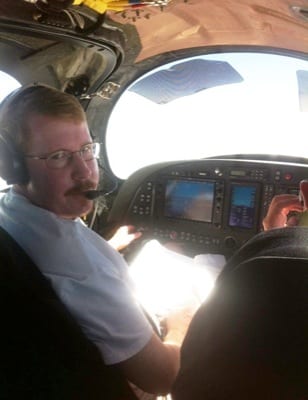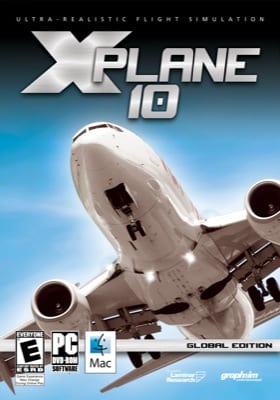As a college student, Austin Meyer was finding it difficult to keep up his instrument currency.
Like so many pilots at the time, he was using Microsoft Flight Sim, but “I wasn’t happy with its flexibility,” he recalled. “I was having a heck of a time passing my currency check.”
That’s when he turned his dorm room into a computer lab and created his own flight simulator, now known as X-Plane, which actually predicts how an airplane will fly.
A pilot since he was 16, Meyer studied aerospace engineering at Iowa State University and computer science at Carnegie Mellon University. He combined all that to create his first sim called Archer-II IFR to simulate almost any airplane imaginable by plugging in aircraft blueprints.
 He then wrote simulator code called “blade element theory” that creates aerodynamic forces in the computer to accurately model the flying characteristics of an aircraft. He continued to test various designs, eventually renaming the simulator program X-Plane in honor of a series of aircraft tested at Edwards Air Force Base in the 1960s.
He then wrote simulator code called “blade element theory” that creates aerodynamic forces in the computer to accurately model the flying characteristics of an aircraft. He continued to test various designs, eventually renaming the simulator program X-Plane in honor of a series of aircraft tested at Edwards Air Force Base in the 1960s.
His company, Laminar Research, recently released X-Plane Version 10.20, a 64-bit version that solves the challenges of customers unable to keep up with the larger memory requirements of the sim due to the more complex aircraft models, higher resolution textures, and improved scenery.
While X-Plane is a “great tool for pilots of all levels looking to learn or maintain currency,” it has expanded far beyond that, according to Meyer. He notes that officials at Cirrus Aircraft used X-Plane to virtually fly the Vision Jet while it was in development.
 On another new design, the Visionaire Vantage, Meyer was a bit skeptical about the predicted performance characteristics. “The numbers sounded optimistic to me,” he said, “so I flew the airplane before it even existed.”
On another new design, the Visionaire Vantage, Meyer was a bit skeptical about the predicted performance characteristics. “The numbers sounded optimistic to me,” he said, “so I flew the airplane before it even existed.”
The sim can serve as a “sanity check,” he noted. “X-Plane doesn’t care what you hope the plane will do.”
That’s why “countless” organizations are using the sim to test aircraft ranging from an autogyro in Texas to what it would be like to fly a glider over Mars, he said.
Of course, for most people, the sim is a way to indulge their love of aviation. Pilots can practice, doing everything from shooting VFR and IFR approaches to improving navigation skills and preparing for emergencies. It also lets you fly your airplane from your home airport. Feel like flying something different? Aircraft range from the Cessna 172 to F-22 to the Space Shuttle.
X-Plane has a “couple of hundred thousand” users who are quite loyal, according to Meyer.
“Once they start flying X-Plane, they don’t stop,” he said.
That’s because the sim is “more fun to fly,” he added.
 “The airplane flies like a real airplane,” he said. “And there is unending variety and unending appeal. As long as people keep dreaming up new airplanes, they can fly them.”
“The airplane flies like a real airplane,” he said. “And there is unending variety and unending appeal. As long as people keep dreaming up new airplanes, they can fly them.”
And what’s cool is that you’ll never have the same flight twice.
“You’ll never have a perfect flight,” he said. “There are so many variables — wind, flight controls, the input from the pilot. X-Plane does a better job than any other sim to give the feeling of interacting with all that randomness.”
X-Plane will continue to evolve, thanks, in part, to feedback from its customers, he said. “Everybody has different ideas of what makes the perfect sim,” he said.
He’s also heard from many customers who began flying on their computers and are now flying real airplanes. He tells the story of Jay Oliver, the keyboardist for the rock band the Eagles, who honed his skills on X-Plane, then flew an instrument approach the first time he ever flew a real airplane.
“X-Plane flies like the real thing,” he said. “People can get so much practice flying it — that’s what it was initially designed for.”
The fight of his life
Last year while at AirVenture in Oshkosh, Meyer got a call from a lawyer in Texas. That’s how he found out he was being sued by Uniloc for patent infringement. The Texas company claims that the X-Plane app for Android infringes on its 2001 patent for software that checks computer databases to ensure a program has been paid for.
Meyer, who used source code from Google for the Android app, has vowed to fight the lawsuit against Uniloc, which he calls a “patent troll.”
He’s initiated a White House petition to persuade the government to make it more difficult for companies to file frivolous patent lawsuits. He estimates fighting the lawsuit will cost $2 million and two years of his life. That’s why most companies settle these kinds of lawsuits, he noted. But not Meyer.
“I will spend everything I have or will have because I believe this is wrong,” he said. “We should not have to pay extortion.”
He hopes by not settling it will alert people to what is going on with these patent trolls. Besides the current economic costs, these kinds of lawsuits also hinder innovation, he noted.
“I won’t do any more apps for Android,” he said. But there’s more: Fighting this fight means there will be “other products that don’t get created, revenues I won’t make and tax dollars I won’t pay,” he said.

I know my offer is small potatoes, but I will give up an hour of actual flying time to donate to Laminar, or better yet, pay a premium for the XPlane to help with this very unfair fight
that is being forced by an unethical attorney.
I really hope google decides to back Laminar on fighting the law suite, its not really their fight but I think it would hinder would be app developers. Unfortunately there is a patent on many things that shouldn’t be patentable, the one for using GIF images to provide online flight planing (FlightPrep) has hit many people wanting to make products. maybe Austin Meyer should contact eff.org they are in the process of trying to bust bad patents. https://www.eff.org/deeplinks/2011/01/when-bad-patents-hurt-good-people-patent-threat